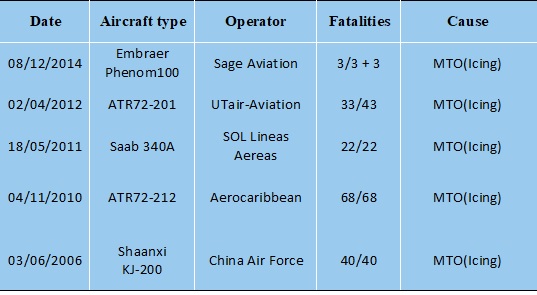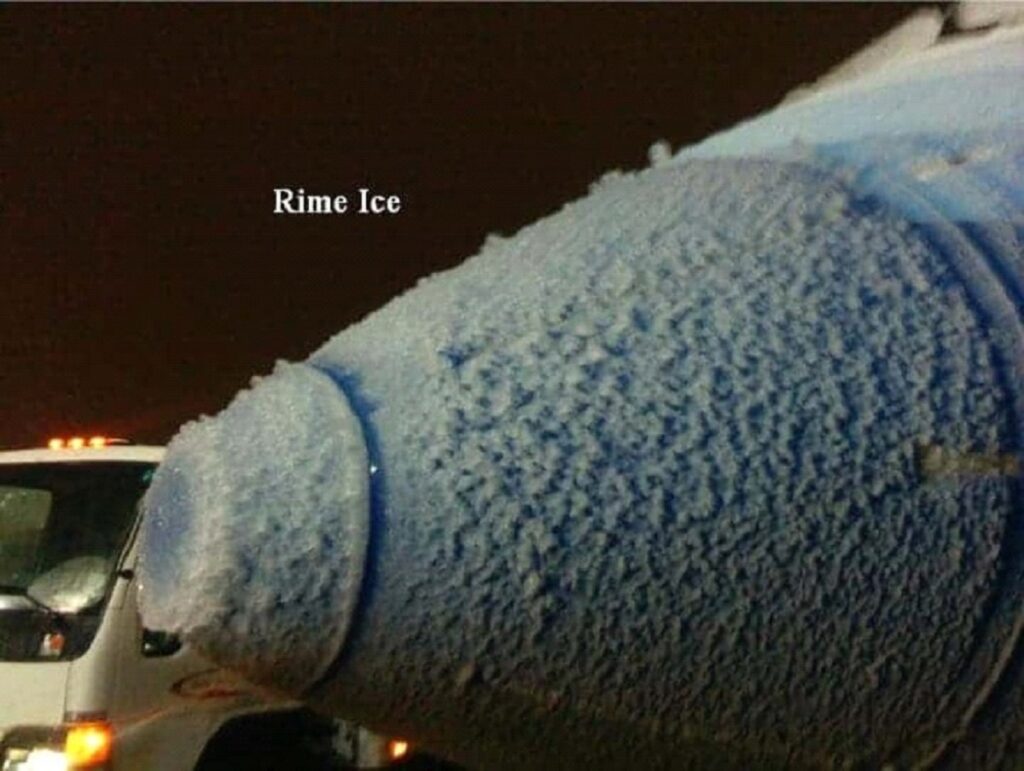Icing can be defined as a form of contamination consisting of a coating of ice on the surface of an object. In aviation, this will consist of the formation of ice on the surface of an aircraft or inside an engine. Icing is characterized by the presence of super cooled water droplets in the air and manifests itself in several forms:
Rime Ice

A milky white or opaque colored ice that deposits on the surface of the aircraft when it passes over film clouds is classified as icing. It is usually formed from small super cooled droplets. Rime deposits do not have much weight, but they are still dangerous because they alter the aerodynamics of the wing camber and affect the instruments. Rime ice is generally brittle and can be dislodged quite easily with de-icing equipment.
Clear Ice

Clear ice is when a thick layer of ice forms when an aircraft passes through clouds containing large amounts of large super cooled droplets. Clear ice is extremely dangerous; it causes the aircraft to lose lift because it changes the camber of the wings and disrupts the airflow over the rear surface and the wings of the aircraft. In addition, it increases the drag, which is dangerous for the aircraft.
Mixed ice

As the name suggests, mixed ice is the type of ice that has the properties of both rime and clear ice. It forms when small and large super cooled droplets are present.
Frost

A very thin layer of natural ice that forms on an aircraft surface below 0 ° C. This has no major effect on the flight, but it can obscure the pilot’s vision by covering the aircraft windshield. It can also interfere with radio signals by forming in the antenna.
Icing effects on aircraft
Ice can have an adverse effect on the aircraft, depending on the surrounding temperature, the speed of the aircraft, the shape and temperature of the aircraft surface, and the size and concentration of particles in the air.
Ice can accumulate on the surface of the aircraft and interfere with the operation of the wings, propellers and control surface as well as canopies and windshields, pitot tubes, static vents, air intakes, air carburetors and radio antennas

The aircraft’s turbine engines are extremely vulnerable. Ice that forms on the intake hood can constrict the air intake. When ice forms on the starter blades and rotor, it degrades their efficiency and performance and can even lead to flameout. When pieces of ice break off, the motor can suck them up. This can lead to structural damage.
In-flight icing destroys normal airflow, increasing drag while decreasing the structure’s ability to create lift. The actual weight of the ice loaded on board an airplane is insignificant when compared to the disruption to airflow it induces. As power is increased to compensate for the additional drag and as the nose is raised to maintain altitude, the angle of attack increases, causing under the wings and fuselage to accumulate additional frost.
Approaches and landings in icing conditions can be dangerous. When landing an iced aircraft, pilots should use more speed and power than usual.
Flight instruments may not function if ice builds up on the airplane static pressure ports and Pitot tube. Rate of climb, airspeed and altimeter may be affected.
Aviation accidents caused by icing
The meteorological phenomena and atmospheric conditions that are hazards with the potential of causing aircraft accidents are well known. Here is some of the most fatal recent aviation accidents caused by icing. (Source: Aviation safety net –Database)

Reference:
⦁ https://aviation-safety.net/database/
⦁ https://www.aircraftcompare.com/blog/types-of-aircraft-icing/⦁https://rmets.onlinelibrary.wiley.com/doi/full/10.1002/met.1686
⦁ https://fr.wikipedia.org/wiki/Givrage_(aéronautique)

Author – Yaninthé Tiomene Douanla
Civil Aviation Engineer






